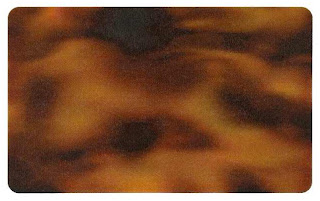Credit Card Background Design Not a Mark, Says TTAB
Affirming a PTO refusal to register, the Board found that the tortoise shell background design of Banana Republic's credit card does not function as a trademark. Rather it is "simply a decorative design [and] will not be perceived as mark." In re Banana Republic (Apparel), LLC, Serial No. 78485048 (May 29, 2007) [not precedential].

Applicant Banana sought to register "a credit card face with a translucent background consisting of the mottled colors orange, black and brown that represent a tortoise shell pattern" for credit cards, credit card services, and administration of loyalty programs.
Examining Attorney Leigh A. Lowry maintained that the supposed mark is a non-distinctive background design that does not function as a mark. She relied on web page printouts from other credit card companies allowing customers to select different background designs for their cards.
Banana argued that its proposed mark is not merely ornamental, but primarily functions as a source indicator. It claimed that it has drawn attention to the tortoise shell design in direct mailings, coupons, and store event invitations.
The Board perceptively observed that [w]hether a design is merely ornamental or functions as a trademark is a matter of public perception." It first agreed with the Examining Attorney that Banana's design is not inherently distinctive under the test [for product packaging] set forth in Seabrook Foods, Inc. v. Bar-Well Foods, Ltd., 196 USPQ 289, 291 (CCPA 1977). A number of credit card issuers offer a selection of background designs for their cards, including "geometric shapes such as angles, curves, and swirls."
"... because the use of background designs on credit cards appears to be widespread, and because the tortoise shell design is clearly decorative in nature, the public will perceive the tortoise shell design as a version or a refinement of a commonly used form of decoration for credit cards, not as a trademark."
Moreover, the Board found no evidence that Applicant "ever promoted or drew attention to the tortoise shell design so as to encourage consumers to view it as a trademark."

Banana contended that its design is different because Banana's customers do not have a choice of background decorations: i.e., "its unique, mandatory, tortoise shell design identifies a single source." But the Board found that Banana's use of a background design "is not unique or unusual, but is simply a refinement of an already existing practice."
The Board noted that this case is somewhat unique because the ornamentation is being used in connection with services instead of goods, and services cannot be "ornamented." However, the credit card is the "physical embodiment of the services," and the design on the card will not be perceived as a mark for the services.
In sum, the Board ruled that the tortoise shell design is not inherently distinctive and does not serve as a mark because:
"(i) it is not unique or unusual in the field; (ii) it is a mere refinement of the common practice of using background designs on credit cards; and, (ii) it does not create a commercial impression distinct from the written matter that appears on the card."
And so the Board affirmed the refusal to register pursuant to Sections 1, 2, 3, and 45 of the Lanham Act.
Text Copyright John L. Welch 2007.




0 Comments:
Post a Comment
<< Home